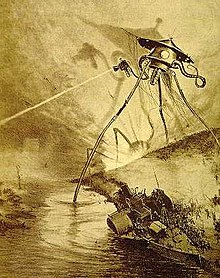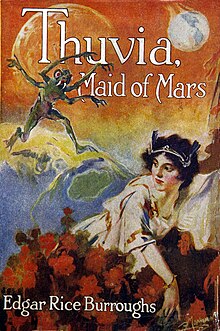Martians

Martians , also called Martians , are fictional, highly civilized creatures on the planet Mars , whose existence was widely assumed from around 1890 - also by astronomers and well-known scientists from other fields. The Martians are one of the most famous and oldest examples of hypothetical extraterrestrial life . The idea of an inhabited Mars - on which one is still looking for traces of simple life today - met the technological breakthrough at that time and was fueled by some media to a kind of "Mars fever".
Alien intelligence
The question of the existence of intelligent extraterrestrial life is still a research topic in the humanities and natural sciences and has even led to the financing of some costly research projects.
It goes back on the one hand to centuries-old myths and the thoughts of some famous philosophers , astronomers and biologists , on the other hand specifically to the discovery of the "Canali" (channels, also " Mars channels "), which the Italian astronomer Giovanni Schiaparelli succeeded in 1877 and the 1879 was confirmed at the Nice Observatory . The amateur astronomer Percival Lowell (USA) took Schiaparelli's discovery as an occasion for further research and founded the Lowell Observatory in Arizona, which quickly became famous and, in addition to research on Mars, also carried out spectroscopic astrobiology and where Pluto was discovered 40 years later .
Of life on the moon and on other planets - and even on the sun - mankind has been dreaming at least since the beginning of written tradition. These thoughts became more concrete, among others, by Greek natural philosophers and around 1600 by Johannes Kepler . When later large astronomical telescopes were aimed at our neighboring planets, only Venus and Mars remained of these dreams , while Hieronymus Schröter assumed the uninhabitability of the Earth's moon as early as the 18th century . It was already clear at the turn of the century that the direct neighboring planet Venus has an atmosphere that is toxic to humans, while this finding for Mars was only made around 1950.
On the history of the "Martian canals"
The habitability of other planets and so-called exoplanets cannot be ruled out in principle, but - if this can be proven - the forms of life could differ significantly from the terrestrial forms (see the newly discovered sulfur bacteria in the deep sea). But the driving force of “non-scientific” considerations and frequent greed for sensation should not be underestimated when asked about “extraterrestrials”. The discovery and misinterpretation of the Martian canals is a prime example of this.
The Martian canals (more modestly called “Canali” in Italian) are delicate lines on the Martian surface that go back to some large canyons and / or to differences in the albedo of the “Red Planet”. Other causes of the phenomenon can be several rows of craters and terrace-like, flat shadow effects. From around 1950 the view prevailed that there were optical illusions at a certain resolution of telescopes, although around 1965 some of these structures turned out to be real (especially the Valles Marineris ).
When Schiaparelli announced his discoveries - only confirmed two years later by less keen-eyed astronomers - he simply spoke of presumed "channels (ital. Canali) on Mars". This would in English Channels welcomed, but were Canals of it, which of course - especially in German - also or primarily as artificial was interpreted channels. Numerous newspapers soon turned this initially rather linguistic problem and a cautious scientific question into a fact .
Around the same time - the Mars opposition of 1877 was astronomically extremely favorable - one could also discover many details on the polar caps of Mars. For journalists and some popular astronomers such as the French Flammarion (and Lowell, of course ), the idea of associating the periodic melting of the polar ice caps with the "Canali" was obvious. Soon the deliberate misinterpretation, or one born out of enthusiasm and sensationalism, was perfect, interpreting the "canali", which can only be recognized by the practiced, as artificially created irrigation channels with which the little water on the desert-like "red planet" leads from the icy polar caps to the dry equatorial regions has been. In addition, there was a seasonal change in color of several landscapes lying on the Canali from gray or reddish tones to a delicate green or blue-green, which in some cases still does not seem fully understood.
A late effect of this Martian fever was the discovery of the " Martian face " in the Cydonia region around 1970 , which was immediately mistaken for a relic of an earlier Martian civilization by numerous book authors. The "disenchantment" with even sharper photographed Mars probes was naturally a much lower media coverage than the first, by Erich von Daniken reports today quoted.
Origin of the myth of the "Martians"

This decades-long misinterpretation - which existed with regard to the expectation of low life until the flight of the space probe Mariner 4 in 1965 - contributed to the seasonal-periodic color changes of the Martian plains between greenish, gray and red-brown. Today the "channels" are mostly explained as artifacts of the then only medium-sized telescopes, but some correspond to existing line structures such as terrain and terrace steps, large canyons and long rows of craters.
The media of the late 19th century contributed significantly to the development of the hypothesis of the “Martians”, as did well-known astronomers such as Camille Flammarion and Percival Lowell . Since the Canali could only be seen in telescopes from about 30 cm opening, they had to be over 100 km wide due to the great distance of Mars and the annual discoloration suggested accompanying wide belts of vegetation . Other reasons to adopt life on Mars included:
- periodic sandstorms and the subsequent re-greening of some areas
- Evidence of atmospheric oxygen and indications of temporary temperatures up to around 20 ° C
- Summer "drying out" (slow disappearance / return of lineaments , often at an interval of half a Martian year)
- Cosmological ideas about the development of the planets: the dense Venus clouds as an indication of a “young” planet, whereas the Martian deserts indicate a dying celestial body, and the earth in between.
- the current construction of two large shipping canals ( Suez Canal and Panama Canal ) and
- based on these successes, the assumption that even Martians would not stand idly by a climate change .
Popular science, media and science fiction


These considerations and speculations were fueled by some US and French newspapers and by the popular scientific publications of Lowell and Flammarion, but also by the literary successes of Jules Verne .
The "Martians" gave rise to the establishment of a new type of science fiction literature, which even then corresponded to the taste of many contemporaries . From a (earlier) series of futuristic works, three particularly stand out:
- the war of the worlds by HG Wells
- the naturalistic radio play of the same name by Orson Welles , which in 1938 unsettled many Americans due to its similarity to radio news,
- and the Mars Chronicles by Ray Bradbury .
In The Things that Live on Mars , written for Cosmopolitan Magazine in 1907 , Wells speculated about what Martians might look like. When the magazine commissioned the painter William Robinson Leigh (1866–1955), who actually specialized in western scenes , to paint pictures for the performances, these depictions had a lasting impact on our image of Martians with oversized heads, antennae and green skin.
While the Martians were portrayed as a threat to our existence in most literary works, in George du Maurier's novel The Martian they provided the impetus for a spiritual and moral advancement of humanity.
Todays situation
Even if the Mariner 4 space probe was largely able to rule out the existence of Martian canals in 1965 - the numerous Martian craters and arid regions discovered did not silence similar hypotheses. When space probes actually discovered channels in a dried-out state, public interest in the “red planet” shifted to the proof of the existence of water, something that space agencies such as ESA and NASA are still concerned with today.
The "little green men" and other exaggerations of the science fiction authors still encourage film and television to produce a wide variety of productions, but they also have some scientific good things:
- the emergence of informative programs such as "Alpha Centauri"
- Keeping the general public and the
- appropriate political environment to secure enough money for astronomy for research projects .
A similar effect can be observed with the "danger from space" caused by possible impacts by asteroids .
In research-based astronomy and space travel , several aspects have been related to possible life on Mars for years: the search for water and water ice , the necessary geological conditions in the Martian rock , the detection of landslides , the search for traces of life in the Martian rock ( bacteria , possible microscopic lichens ) and in meteorites from Mars , the composition and development of the Martian atmosphere and, last but not least, plans for the possible enrichment of this relatively thin atmosphere.
See also
- Aliens , Venusians , Grays
- Mars Attacks , The Next Wave - War of the Worlds 2 , Mars Society , Red Planet
- Exobiology , Lowell Observatory , Terraforming , Exosociology
- Mars Rover , Mars Global Surveyor , Viking
literature
- HG Wells : The War of the Worlds Diogenes, ISBN 3-257-20171-0
- Ray Bradbury : The Mars Chronicles Diogenes, ISBN 3-257-20863-4
- Kurd Laßwitz : On two planets Felber, Weimar from 1897
- Orson Welles : War of the Worlds ... (and Welles' radio play 1938)
- Walter Hain : Das Marsgesicht Herbig-Verlag Munich and Wels 1995
- Helga Abret , Lucian Boia : The century of the Martians: The planet Mars in science fiction up to the landing of the Viking probes in 1976. Heyne-Verlag, Munich 1984. ISBN 3-453-31022-5
- Edgar Rice Burroughs : John Carter of Mars
